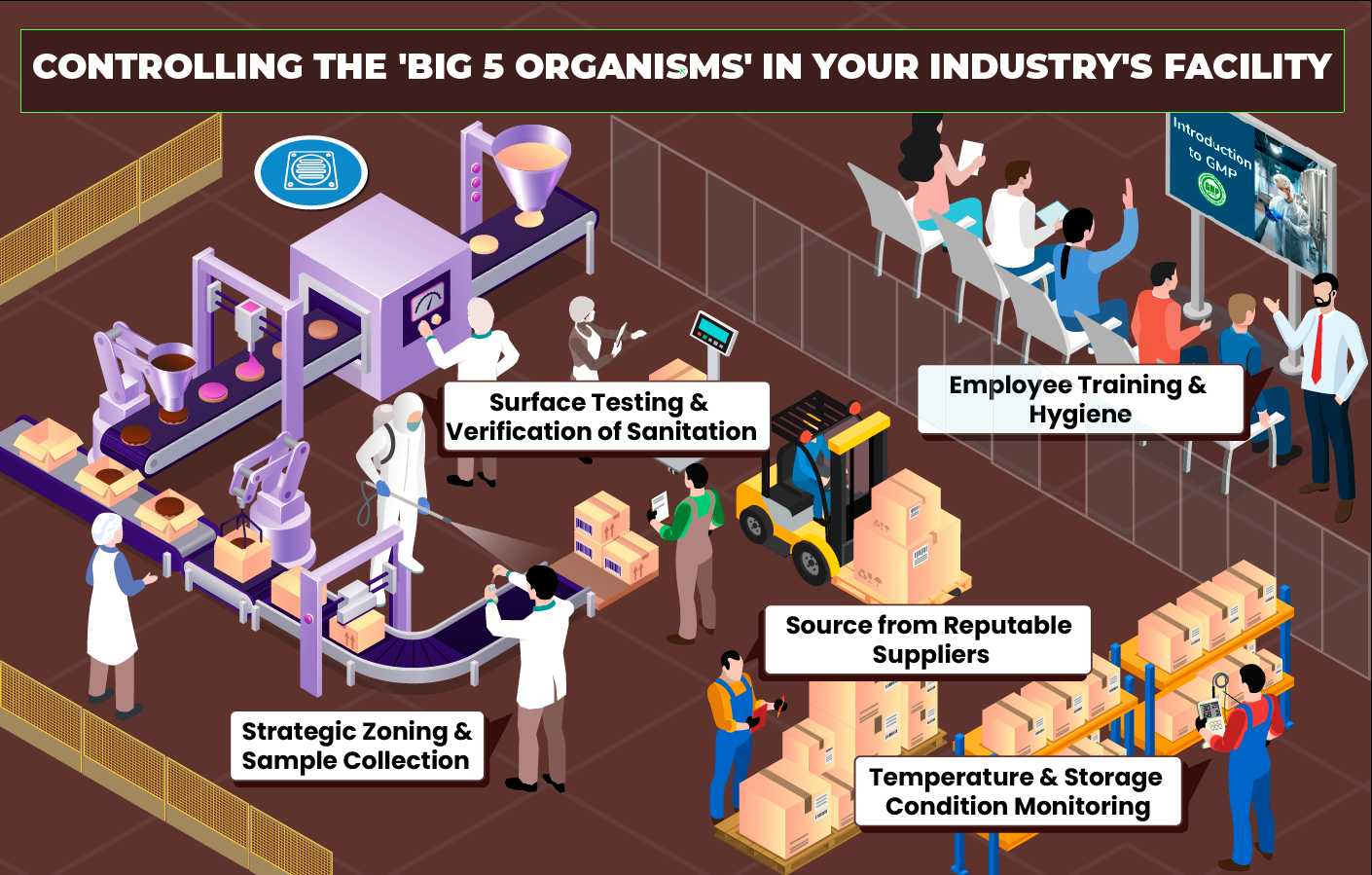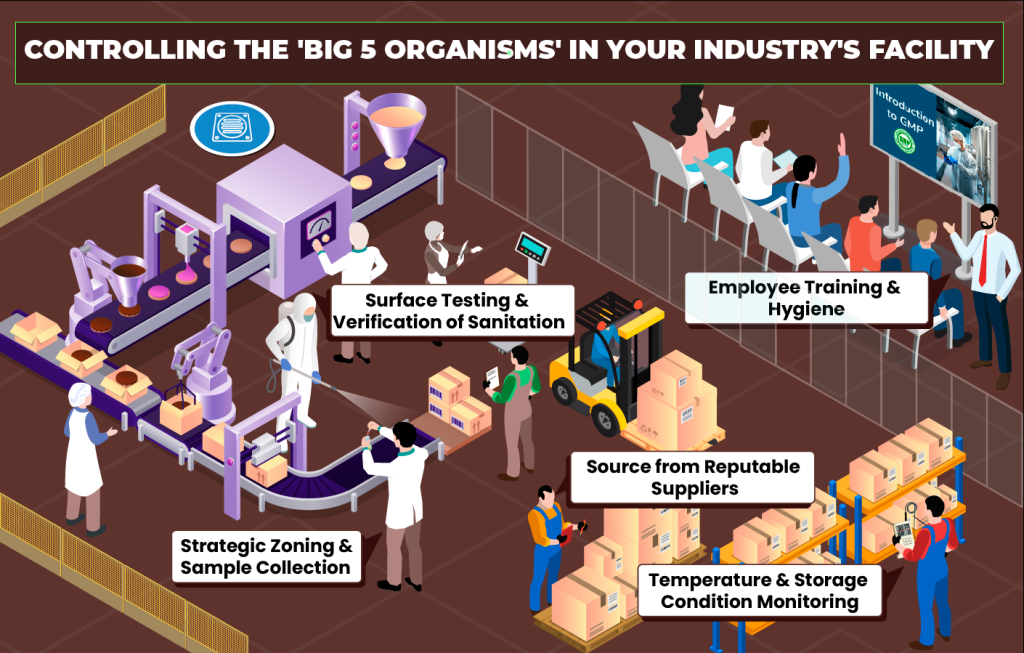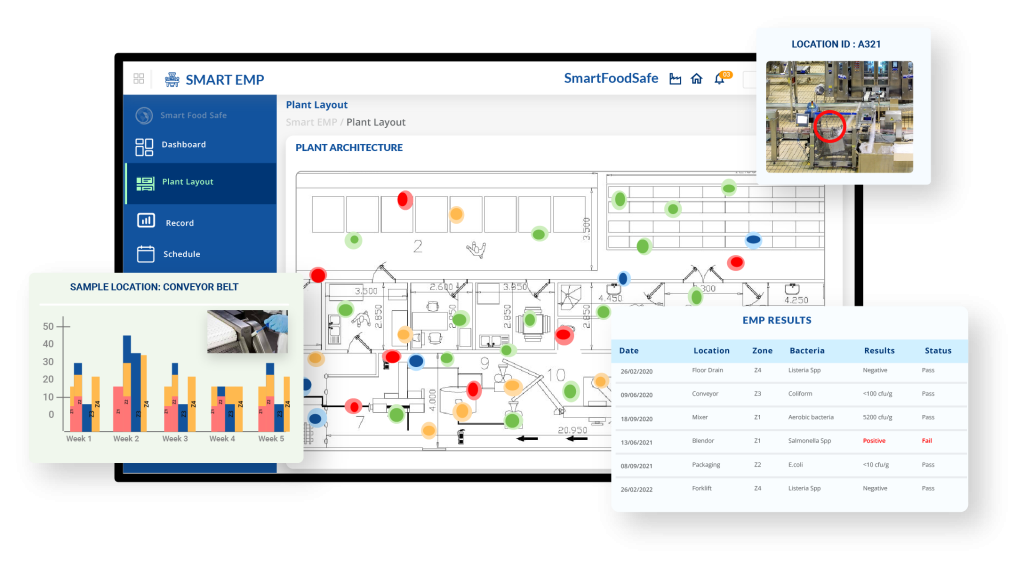
Have you heard of the ‘big 5 organisms’?
Among the various microorganisms that can compromise food safety, five notorious pathogens stand out: Norovirus, Hepatitis A, Salmonella Typhi, Shigella spp., and E. coli O157. Known as the “Big 5,” these organisms pose significant risks due to their virulence, ease of transmission, and the severe health effects they can cause.
For industries aiming to maintain rigorous standards of hygiene and safety, understanding and managing these pathogens is paramount. Here we dive into the practical strategies for minimizing contamination from the big 5 organisms and ensuring a safer environment, focusing on a risk-based environmental monitoring program (EMP) and other essential facility practices.
What are the ‘Big 5 Organisms’?
1. Norovirus
Known for its rapid person-to-person spread, especially in closed environments, Norovirus is a highly contagious virus responsible for many cases of foodborne illness.
- Transmission: Norovirus spreads primarily through the fecal-oral route, often due to improper hand hygiene, contaminated food, or surfaces. Airborne transmission can also occur when an infected person vomits.
- Symptoms: Symptoms include sudden vomiting, watery diarrhea, nausea, and abdominal cramps, typically lasting 24 to 60 hours.
2. Hepatitis A Virus (HAV)
Hepatitis A is less common in countries with high sanitation standards but can still pose a risk due to global food supply chains. Infected individuals may carry the virus for weeks before symptoms appear, making early detection challenging.
- Transmission: HAV spreads through the fecal-oral route, often due to contaminated water, raw shellfish, or food handled by an infected person practicing poor hygiene.
- Symptoms: Common symptoms include fever, fatigue, nausea, abdominal pain, jaundice, and dark urine, appearing 15-50 days after exposure.
3. Salmonella Typhi
Known for causing typhoid fever, Salmonella Typhi is another pathogen that spreads through food and water contaminated with human waste. Although less common in high-sanitization regions, outbreaks can still happen, often due to asymptomatic carriers who continue to shed the pathogen.
- Transmission: The pathogen spreads through ingestion of contaminated food or water, and carriers can remain infectious for extended periods.
- Symptoms: Symptoms include high fever, headache, constipation or diarrhea, and abdominal pain. Complications can be life-threatening.
4. Shigella spp.
Shigella, responsible for shigellosis or bacillary dysentery, is a particularly virulent organism that can cause severe symptoms. Common in crowded, unsanitary environments, Shigella is transmitted mainly through direct person-to-person contact.
- Transmission: Shigella spreads via fecal-oral transmission, often linked to contaminated food, water, or poor personal hygiene.
- Symptoms: Symptoms include bloody diarrhea, fever, stomach cramps, and nausea. Symptoms may appear within hours of exposure and can persist for up to two weeks.
5. Escherichia coli O157 (E. coli)
E. coli O157 is a shiga toxin-producing bacterium (STEC) that causes severe illness, particularly among children and immunocompromised individuals. Known for its association with undercooked beef, E. coli is a pathogen that requires high vigilance in food processing and handling.
- Transmission: The bacteria spread through contaminated food (particularly undercooked beef), unpasteurized milk or juices, and sometimes produce.
- Symptoms: Symptoms typically appear 2 to 5 days after exposure and include severe diarrhea (often bloody), abdominal cramps, nausea, and in extreme cases, kidney failure due to hemolytic uremic syndrome.
Exercising Targeted Pathogen Control for the ‘Big 5 Organisms’; Environmental Monitoring Program (EMP)
Understanding the threats posed by the Big 5 pathogens sets the stage for adopting an effective control strategy. This is where an Environmental Monitoring Program (EMP) comes into play. EMPs are designed to identify potential contamination risks in industrial facilities by regularly testing and analyzing environmental samples from surfaces, equipment, water, and even the air. In this way, an EMP acts as an early warning system, helping businesses curb pathogens before they can spread and cause contamination. Here’s how well-developed EMPs can contribute to controlling the Big 5:
A. Strategic Zoning and Sample Collection
⇒ Facilities can be divided into zones based on the risk of contamination. For example, food manufacturing areas where raw foods are handled (Zone 1) may have different risks than packaging areas (Zone 2).
⇒ Regular surface swabbing and environmental testing in high-risk zones can detect pathogens like Norovirus and Shigella early.
B. Surface Testing & Verification of Sanitation
⇒ Routine swabbing of product contact surfaces for pathogens like E. coli and Salmonella ensures that cleaning protocols are effective. By testing for pathogens on countertops, and storage areas, businesses can verify that disinfection procedures are sufficient to prevent contamination.
⇒ Test results from EMP sampling can verify whether cleaning protocols are adequate or if adjustments are needed to prevent pathogen buildup.
⇒ Environmental monitoring can also track hygiene compliance by testing surfaces that employees frequently touch, such as door handles and sinks.
C. Trend Analysis & Continuous Improvement
⇒ One of the most powerful benefits of an EMP is the ability to analyze trends over time. By collecting and reviewing data from regular tests, facilities can identify patterns in contamination risks from any of the Big 5 organisms and adjust their cleaning and sanitation procedures accordingly.
⇒ For instance, if recurring contamination is found in a particular area of the facility, the EMP can guide targeted cleaning and disinfection efforts.
Implementing Practical Control Measures in Conjunction with EMP
While an EMP is imperative for early pathogen detection, a combination of hygiene practices and facility controls strengthens contamination prevention.
Sanitation & Surface Disinfection: Disinfect high-touch surfaces frequently. For Norovirus and E. coli, thorough cleaning using chlorine-based sanitizers is effective in destroying viral and bacterial particles. Facilities should implement measures to ensure proper air filtration and ventilation, particularly in production and storage areas where airborne contaminants might pose a risk.
Temperature & Storage Condition Monitoring: Maintain strict temperature control, as heat effectively kills pathogens like E. coli and Salmonella Typhi. Store food at recommended refrigeration temperatures to minimize bacterial growth. Automated temperature sensors in storage areas are employed to ensure that foods remain at safe temperatures continuously.
Source from Reputable Suppliers: Ensuring that suppliers follow strict sanitation protocols can reduce the risk of introducing pathogens into your facility. Implement a supplier verification program to confirm that your ingredients, especially high-risk products like seafood and fresh produce, are sourced safely. Consider implementing testing protocols for raw materials, especially those at higher risk of harboring pathogens.
Exclusion & Symptom Monitoring for Employees: Exclude employees showing symptoms associated with the Big 5 (e.g., vomiting, jaundice, fever, diarrhea) until they are medically cleared to return. Implement health screening procedures to detect and prevent employees from handling food when they are sick. This proactive measure helps prevent asymptomatic carriers from inadvertently spreading pathogens in the facility.
Employee Training & Hygiene: Regular training on hand hygiene and proper PPE use reinforces best practices and keeps staff vigilant against potential contamination. All employees must stay aware of the necessary hygiene protocols to follow them religiously, especially those who come into contact with high-risk surfaces. Proper hand hygiene is one of the most effective ways to prevent pathogen transmission and hence, businesses should install handwashing stations in key locations throughout the facility.
Smart EMP: Building a Culture of Safety Against the ‘Big 5 Organisms’ Through Innovative EMP Implementation
Smart EMP is an environmental monitoring software capable of automating each step in the EMP process to be set up to control the ‘Big 5 Organisms’. With features like end-to-end automation, real-time digital plant layouts, configurable zones, and automated workflows, Smart EMP enables businesses to stay on top of hygiene practices with ease. Integrated FDA Listeria guidelines ensure compliance, while a heat and harborage map, trend analysis, and comprehensive dashboards provide invaluable insights into contamination patterns. Whether scheduling fixed or random sampling, configuring corrective actions, or managing lab integration, Smart EMP streamlines every aspect, making food safety compliance against the ‘Big 5 Organisms’ more manageable and proactive.




